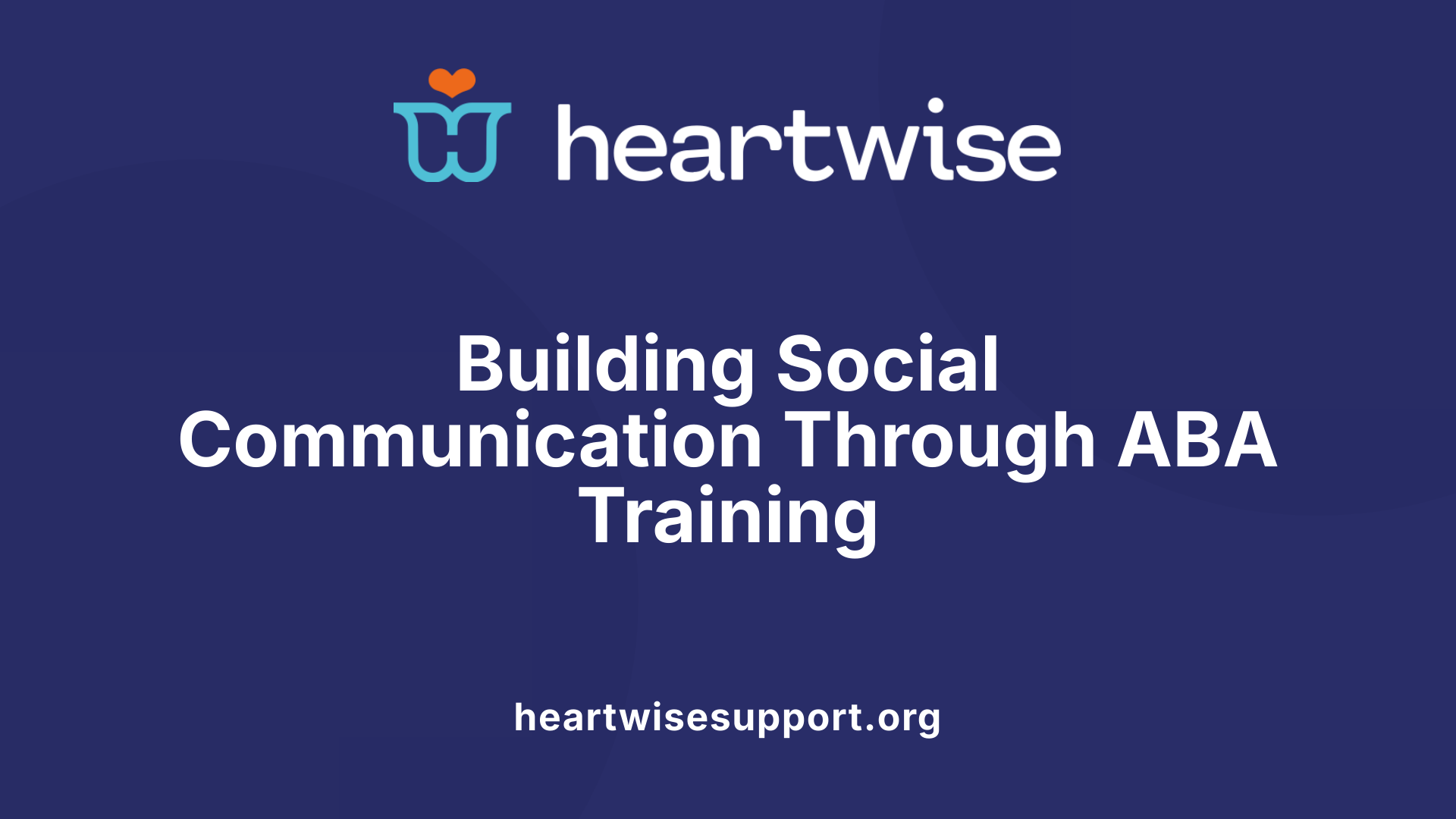Introduction to Applied Behavior Analysis and Communication
Applied Behavior Analysis (ABA) stands as a cornerstone in developing effective communication skills, particularly for individuals with Autism Spectrum Disorder (ASD). Recognized for its structured and evidence-based methodologies, ABA focuses on incrementally teaching new skills and modifying behaviors. This article delves into how ABA utilizes such methods to foster communication skills, emphasizing its principles, strategies, and outcomes.
The Role of ABA in Communication Development

What are the benefits of applied behavior analysis?
Applied Behavior Analysis (ABA) is a foundational approach for enhancing communication skills in children with Autism Spectrum Disorder (ASD). ABA therapy is centered around the principles of behavior modification, focusing on increasing desired behaviors and reducing problem behaviors. This systematic method can lead to significant improvements in adaptive behaviors, communication skills, and social interaction.
One of the primary benefits of ABA is its evidence-based nature. Research studies show that children receiving intensive ABA interventions can achieve small to moderate gains in communication abilities. In fact, some reports suggest an 89% success rate in achieving treatment outcomes. This impact is especially notable among children with lower functioning levels, where consistent application of ABA techniques translates into enhanced expressive language skills.
Additionally, ABA’s customization allows therapists to tailor strategies to meet the unique needs of each child. This personalization ensures that interventions are relevant and practical, addressing specific communication challenges effectively.
However, while ABA holds significant potential, challenges such as high rates of service discontinuation and variability in treatment received can affect its overall effectiveness. Economic factors and lack of institutional support often hinder access to consistent ABA services. Parental advocacy and engagement are critical in overcoming these hurdles to maximize the benefits of ABA therapy.
In conclusion, while ABA provides vital support for communication development in children with ASD, the effectiveness of these interventions relies heavily on ensuring that therapies are consistently delivered and tailored to individual needs.
Strategies for Enhancing Receptive Language

Does ABA help with receptive language?
ABA therapy employs various evidence-based strategies to improve receptive language skills. One of the primary methods used is Discrete Trial Training (DTT). This structured teaching method breaks down skills into small, manageable components, allowing children to learn in a systematic way. This strategy also helps in reinforcing understanding through repetition and practice, which is essential for mastering new concepts.
Another effective approach in ABA is the use of visual supports. For instance, using picture boards can aid children in comprehending verbal instructions. These visual aids help bridge the gap between spoken language and understanding, enhancing the child's ability to follow directions.
Tailored approaches to individual needs
Each child has unique communication challenges, and ABA focuses on customizing interventions to meet these needs. Behavior analysts collaborate with experts like speech-language pathologists to develop personalized plans that address specific receptive language goals.
For example, sessions may include activities aimed at improving listening skills, where children learn to process spoken information more effectively. Incorporating reinforcement strategies, such as positive feedback, can further motivate children to engage with and understand language better.
Overall, ABA therapy systematically supports the development of receptive language skills through structured and adaptable strategies, ensuring that each child receives the support they need.
Promoting Social Communication Skills in ABA

How does ABA help communication skills?
Applied Behavior Analysis (ABA) plays a vital role in enhancing communication skills by incorporating social skills training aimed at fostering effective interactions. Through structured interventions, children learn how to initiate conversations, appropriately respond to peers, and engage in turn-taking, which are essential for successful social interactions.
Social skills training includes practical activities like role-playing and modeling, allowing children to practice in a controlled environment. This method not only teaches them the mechanics of conversation but also the nuances of non-verbal communication, such as reading body language and facial expressions.
Here’s a quick overview of how ABA enhances social communication:
| Focus Area | Description | Outcome |
|---|---|---|
| Initiating Conversations | Children learn how to start conversations confidently. | Increased engagement with peers |
| Turn-Taking Skills | Practice taking turns during discussions. | Improved conversational flow |
| Understanding Social Cues | Training to recognize body language and facial expressions. | Better interactions and relationships |
Improving peer interactions is paramount in ABA, as it contributes significantly to a child's quality of life. By targeting these skills, ABA therapy enhances self-esteem and encourages positive social inclusion in various environments, making communication more accessible and effective.
Examples of ABA Therapy Applications
What are some examples of ABA therapy?
Applied Behavior Analysis (ABA) encompasses a range of strategies tailored to improve communication and social skills in individuals, particularly children with autism. Here are some prominent methods used in ABA therapy:
Discrete Trial Training (DTT): This systematic approach breaks down skills into small, manageable tasks, making it easier for children to learn. It often includes repetitive practice to solidify these skills.
Natural Environment Training (NET): By teaching skills in real-life settings, NET facilitates the application of learned behaviors in everyday situations, promoting generalization of skills to other areas of life.
Pivotal Response Training (PRT): Focused on pivotal areas of development—such as motivation and communication—PRT encourages children to take the lead in their learning process, boosting engagement and retention.
Functional Communication Training (FCT): This approach teaches children effective communication methods as alternatives to problem behaviors, assisting them in expressing their needs more appropriately.
Use of Visual Supports: Tools like schedules and picture boards enhance understanding by providing visual cues, which can support verbal communication and help clarify expectations.
Positive reinforcement underpins these techniques, where desired behaviors are rewarded to encourage repetition and build confidence.
Practical applications in everyday settings
ABA therapy techniques are adapted for practical application in various everyday environments. For example, therapists might utilize visual supports at home and school to create structured schedules, helping children anticipate daily activities. Social skills training often involves role-playing scenarios to prepare children for real social interactions, helping them integrate more smoothly into peer groups. Overall, ABA's personalized approach focuses on addressing each child's individual communication needs, fostering an effective learning environment wherever children engage.
Understanding Functional Communication Training

What is functional communication training in ABA?
Functional Communication Training (FCT) is an evidence-based intervention used in Applied Behavior Analysis (ABA) to help individuals with severe behavior problems by replacing disruptive behaviors with appropriate communication methods. The process includes several essential steps to ensure efficacy and sustainability:
Functional Behavior Assessment (FBA): This initial step aims to identify the underlying motivations behind the individual's challenging behaviors. Understanding whether a behavior occurs as a means to gain attention, access a preferred item, or avoid a situation is critical.
Replacement Communication Method: Once the reasons for the behavior are determined, a suitable communication method is chosen. This could range from using spoken language, sign language, or augmentative devices like speech-generating devices (SGDs).
Reinforcement of Appropriate Communication: The next step involves reinforcing the use of the identified communication method while ignoring the disruptive behavior. Positive reinforcement encourages individuals to utilize the new communication skills actively.
FCT is particularly beneficial for those with autism or developmental disabilities. It reduces frustration linked to communication difficulties and promotes more effective ways to express needs, replacing behaviors like screaming or physical aggression.
Implementing FCT effectively may require weeks or months, and it's tailored to the specific learning needs and challenges of each individual. Research consistently supports FCT's success in improving communication skills and diminishing maladaptive behaviors across various age groups and settings.
Additional Considerations
The success of FCT relies on continuous support from therapists and caregivers. Following the principles of ABA, consistency and structure are vital in providing a predictable environment where individuals can practice their communication skills and feel confident in expressing their needs effectively.
| Key Component | Description | Benefits |
|---|---|---|
| Functional Behavior Assessment (FBA) | Identifies reasons behind behaviors; crucial first step. | Helps to tailor the intervention to individual needs. |
| Replacement Communication Method | Chooses an appropriate method for communication (e.g., sign language, SGDs). | Facilitates expressing needs more effectively. |
| Reinforcement | Involves rewarding the use of the new communication method while ignoring maladaptive behaviors. | Encourages repeated use of appropriate communication. |
The Collaborative Role of Behavior Analysts
What roles do behavior analysts play in ABA therapy?
Behavior analysts play a crucial role in Applied Behavior Analysis (ABA) therapy. Their primary duties include assessing the needs of individuals and creating personalized intervention plans that address specific communication and behavioral challenges. Board Certified Behavior Analysts (BCBAs) often lead these efforts, utilizing their expertise to determine appropriate strategies to enhance communication skills, foster social interactions, and promote adaptive living.
BCBAs also supervise the work of Registered Behavior Technicians (RBTs) and Board Certified Assistant Behavior Analysts (BCaBAs). These team members implement the strategies designed by BCBAs under their guidance. The collaborative effort ensures that interventions are effectively carried out and adjusted as necessary, enabling individuals to progress toward their goals.
How do behavior analysts collaborate with other professionals?
In addition to their direct work with clients, behavior analysts regularly collaborate with other professionals, such as speech-language pathologists, occupational therapists, and educators. This interdisciplinary approach is vital for developing comprehensive treatment plans that address the multifaceted needs of individuals with autism. The teamwork allows for integrating different therapeutic techniques, ensuring that the communication interventions are not only effective but also conducive to the person’s overall development.
Including various perspectives from different specialists helps tailor interventions to each individual, resulting in better outcomes. This synergy ultimately enhances the quality of life for individuals with developmental disabilities by promoting more effective communication strategies and social integration.
| Role | Responsibilities | Collaboration |
|---|---|---|
| Behavior Analysts | Assess needs, design interventions, supervise staff | Work with other therapists, educators |
| Speech-Language Pathologists | Focus on language development and communication skills | Partner with behavior analysts for holistic approach |
| Occupational Therapists | Enhance daily living skills and sensory integration | Collaborate to support comprehensive treatment plans |
| Educators | Implement learning strategies in educational settings | Coordinate with behavior analysts for consistent strategies |
Through these collaborative efforts, behavior analysts ensure that communication interventions are tailored, evidence-based, and effective, paving the way for individuals to thrive.
Augmentative and Alternative Communication (AAC) Methods in ABA
Various AAC tools used in ABA
Applied Behavior Analysis (ABA) incorporates a variety of augmentative and alternative communication (AAC) tools to assist children with autism in developing their communication skills. Some of the prominent methods include:
- Picture Exchange Communication System (PECS): This system enables children to communicate their needs by exchanging pictures, starting with requests, making it ideal for beginners.
- Speech-Generating Devices (SGDs): These portable devices offer digital communication options and promote social interactions, making them effective for enhancing peer acceptance.
- Communication Boards: Simple visual aids allow children to express their thoughts without verbalizing them.
- Sign Language: As a versatile communication form, it helps in fostering expressive language skills and can simplify transitions between different communication methods.
Adaptability and transition between methods
The flexibility of AAC methods in ABA is crucial for catering to the unique needs of each child. For instance, PECS is often a stepping stone to using SGDs, demonstrating how interventions can evolve based on the child’s progress and comfort. This adaptability ensures that children have continuous support as they strive to improve their communication capabilities.
Long-term Impact of ABA on Communication Skills
Sustained improvements and self-esteem
Applied Behavior Analysis (ABA) therapy offers valuable long-term benefits for individuals with autism spectrum disorder (ASD). By fostering communication skills through structured interventions, children experience sustained improvements in their ability to express themselves and engage with others. As they master these skills, their self-esteem tends to rise, enhancing their overall confidence in social interactions and daily tasks.
Social inclusion benefits
The social inclusion of children with autism significantly improves through ABA therapy. As therapy enhances their communication abilities, they can initiate and maintain conversations, better interpret social cues, and build meaningful relationships. This development not only provides children with a sense of belonging but also promotes greater acceptance from peers, crucial for their emotional and social growth.
| Aspect of Improvement | Impact on Communication Skills | Examples of Long-term Benefits |
|---|---|---|
| Self-esteem | Increased through mastery of skills | Confidence in social settings |
| Social inclusion | Enhanced through effective communication | Stronger relationships and peer acceptance |
Conclusion: ABA as a Pillar of Communication Development
Applied Behavior Analysis (ABA) provides a structured, evidence-based approach to developing communication skills, particularly for children with autism. By utilizing varied strategies like PECS, SGDs, and personalized intervention plans, ABA addresses both expressive and receptive communication needs. Through targeted interventions and consistent practice, ABA not only enhances communication skills but also fosters social inclusion and builds self-esteem, leading to meaningful improvements in the quality of life for individuals with developmental challenges.
References
- 4 Methods for Increasing Communication Within Applied Behavior ...
- Enhancing Communication Skills With ABA Therapy
- Using ABA Therapy to Develop Communication Skills in Children ...
- Applied Behavior Analysis and Communication Services - ASHA
- The effectiveness of applied behavior analysis program training on ...
- Applied Behavior Analysis (ABA) | Autism Speaks
- How Applied Behavior Analysis Supports Communication Skill
- ABA Therapy: A Pathway to Improved Communication Skills











